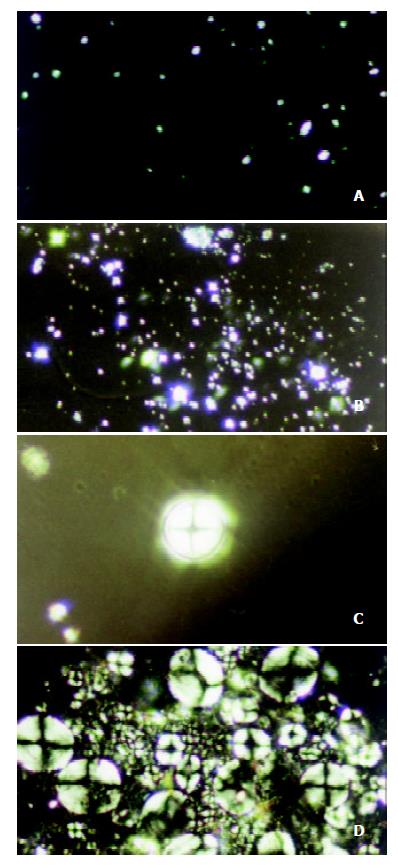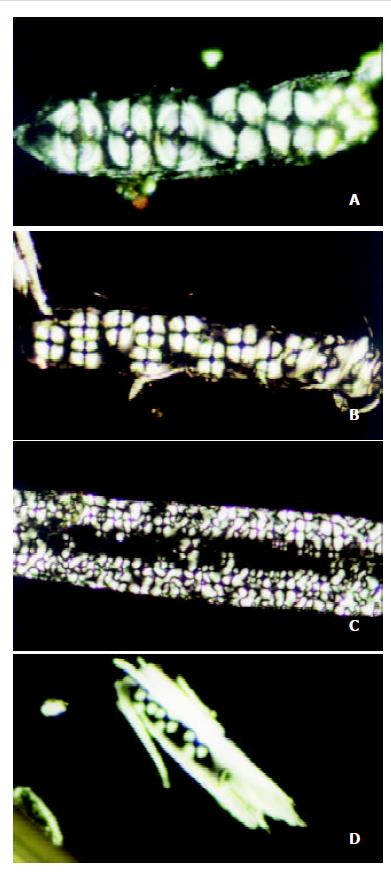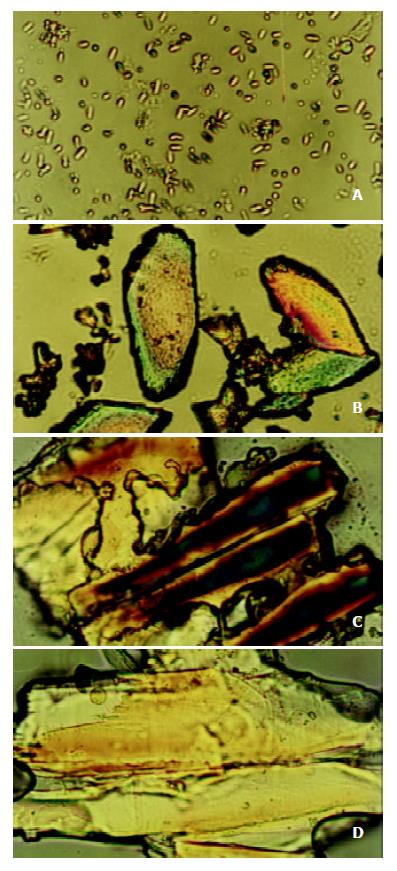MATERIALS AND METHODS
Materials
46 guinea pigs (provided by the animal branch of the Scientific Research Department in Kunming Medical College, with qualified animal testing certificate issued by Yunnan Province), each weighing about 300 grams, half males and half females, were randomly divided into control group (n = 23) and stone-causing group (n = 23).
Methods
Animal raising The control group was given normal feed which was provided by the animal branch of the Scientific Research Department in Kunming Medical College, while the stone-causing group was given stoneleading feed. The two groups were separately raised in flocks, with free access to water containing 1% vitamin C.
Stone-causing feed The components of the stone-causing feed were as follows: starch 25%, bran 25%, glucose 12%, lard 1.5%, cholesterol 1.5%, normal feed 35%[5]. They were mixed evenly and made granule with feed machine.
Sample preparation Guinea pigs were killed in three batches. The first batch was killed after raised for 10 days, with 5 pigs in each group, totally 10 pigs in the 2 groups. The 2nd batch was killed after raised for 25 days, with 5 pigs in each group, totally 10 pigs in the 2 groups. The 3rd batch was killed after raised for 60 days, with 13 pigs in each group, totally 26 pigs in the 2 groups. The pigs were whacked at head to stupor with a blood vessel forceps, immediately cut open belly and their cystic duct was blocked with a blood vessel forceps to take out gallbladder and all bile. The bile was centrifugalized for 30 minutes with a China-made TGL-16B bench centrifuge, 4000 r/min, and observed under polarizing microscope.
Polarizing microscope observation A China-made W-104 micro-sample advancer (precision of 0.2 μL) was used to stratify the centrifuged bile and drip 6.0 μL of it on a carrier flake, then it was covered with the cover-glass and the bile naturally spread out to form slices. Under an advanced polarizing microscope (BHSP model of Olympus, Japan), the pattern changes of the bile liquid crystal in the process of gallbladder stone formation were observed.
RESULTS
Patterns change of bile liquid crystals in control group
Under the perpendicular polarized microscope, the morphological changes of bile liquid crystal in the gallbladder bile of guinea pigs in the control group were observed, and it was found that there were few matters of liquid crystal in gallbladder bile, and that the interference pattern, named Malta cross, was small and scattered, in single form. With the increase of the feeding days, bile liquid crystals grew larger and Malta cross became bigger with their distribution densified unevenly, but always existed in single form, as shown in Figure 1 (a), (b), (c) and (d). No regularly shaped stone crystal was found in the biles.
Figure 1 Malta cross showed in bile liquid crystals in gallbladders of guinea pigs in the control group: (a) Small and scattered crosses (10 days, ×400).
(b) The crosses gradually grew in size and number (25 days, ×400). (c) Single big crosses (25 days, ×400). (d) Densely distributed crosses (60 days, ×400).
The pattern changes of bile liquid crystals in the stone-causing group
Under the polarizing microscope, the morphological changes of bile liquid crystal in guinea pigs’ gallbladders in stone-causing group were observed, and it was found that there were more matters of liquid crystal in gallbladder biles, and that the interference pattern, Malta cross was big and merged into strings. With the increase of the feeding days, bile liquid crystals grew in number and strings of Malta crosses increased and became bigger. The crosses in strings were arranged more regularly so that they gradually phase-changed into stone crystals, as shown in Figure 2 (a), (b), (c) and (d). It exhibited variously shaped stone crystals in the biles, as shown in Figure 3 (a), (b), (c) and (d).
Figure 2 Malta cross shown in bile liquid crystals in gallblad ders of guinea pigs in the stone-causing group: (a) The cross merged into strings (10 days, ×400).
(b) Gradually growing strings of the cross (25 days, ×200). (c) Strings of the cross in phase-changing (60 days, ×400). (d) Stone crystals nucleated by strings of the cross (60 days, ×200).
Figure 3 Gallbladder stone crystals in bile of the stone-caus-ing group.
DISCUSSION
The cause of gallbladder stone is very complicated, various factors are involved[5-9]. The basic factor is now considered to be the change of compositions and physical-chemistry characteristics of biles, which results in cholesterol in the state of super-saturation in the bile. And it is very likely to form crystals, which is then deposited to form gallbladder stones. It also causes imbalance between nucleation-leading factors and antinucleation factors and abnormal function of the gallbladder and so on[10-19]. From the viewpoint of crystallogeny, in a system of solution, the precondition for solute to be separated out and to form crystal is that the solute in the system must be in the state of super-saturation, which is an unstable state in thermodynamics. Only in this state, can the solute be crystallized and separated out. The formation of crystals has two steps of nucleation and crystallization, it firstly forms a crystalline nucleus containing hundreds of molecules, then crystals grow. In a system of solution, spontaneous nucleation of solute often requires a very high degree of saturation, the supersaturated solution in this state is called unstably supersaturated solution. When a certain type of special nucleating factors is added, supersaturated solution of a relatively low degree also can produce nucleation, which is called heterogeneous nucleation, and the supersaturated solution in this state is called substably supersaturated solution[20,21]. Homogeneous nucleation of bile cholesterol requires a very high degree of saturation (estimated at about 300%), which is not possible to occur in human body, and even less possible in guinea pigs’ body. So the formation of gallbladder-stone should be a process of heterogeneous nucleation, stone-causing gallbladder bile should be a substably supersaturated solution, and bile liquid crystal should be a type of nucleating factors for gallbladder stones.
As we observed under the polarizing microscope, there were many substances of liquid crystal in the gallbladder bile of the guinea pigs in the stone-causing group, which were big and string of Malta crosses. With the increase of the feeding days, bile liquid crystals grew in number, more and more strings of Malta cross appeared and steadily became bigger and bigger, and their arrangement became more and more regular, and gradually phase-changed into stone crystals. These have proved that the formation of gallbladder stone is indeed a process of heterogeneous nucleation, and stone-causing gallbladder bile is a type of substably supersaturated solution, and that bile liquid crystal is a type of nucleating factors in gallbladder-stone. Its process of nucleation is such that bile liquid crystals get together, merge and phase change. In another word, single Malta crosses assemble into strings, then merge as slices, and finally phase-change into crystals. The assemblage and merger of bile liquid crystals are the key for nucleation. Although there were also substances of liquid crystal existing in gallbladder biles in the control group and bile crystals also increased with feeding time, they neither assembled nor merged, and Malta crosses always existed in single forms which were unable to nucleate to form stone. If some way can be found to prevent or retard the assemblage and merger of bile liquid crystals, i. e., formation of the nucleus, it will be of a great significance in theory and practice for prevention and treatment of cholelithiasis.
Cholesterol can not dissolve in water, but it can dissolve in bile. The concentration of cholesterol in bile is about 10-20 mmol/L, this concentration is about 106 times[22] denser than that of the solubility of cholesterol in water. Studies concerned pointed out that cholesterol in bile maintained its state of dissolution in forms of micelle and vesicle. Micelle is the polymer of cholesterol, phosphatide and cholate, while vesicle is the compound of cholesterol and phosphatide[23-31]. These two form a system of thermodynamic balance in bile so that they are interlinked and interconverted, and play the role of modulation for dissolution and separation of cholesterol. Under the effect of nucleation-leading factors and antinucleation factors in bile, vesicles in bile assemble, merge and separate out crystalline nuclei of cholesterol which then gradually grow up to form stones[32]. As we observed under the polarizing microscope, single Malta cross in bile liquid crystal of guinea pigs in stone-causing group, gradually assembled into strings, then merged into slices, and finally phase-changed into stone crystals. The present study supports the above viewpoints from the studies of morphology. Whether bile crystal is such a kind of vesicles or vesicles aggregate and what factors cause or stop bile liquid crystal assembling and merging, still need to be further studied.











